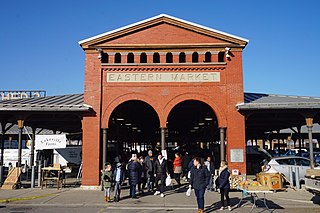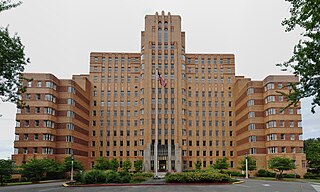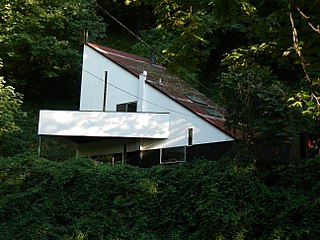
The Century 21 Exposition was a world's fair held April 21, 1962, to October 21, 1962, in Seattle, Washington, United States. Nearly 10 million people attended the fair during its six-month run.

Dearborn is a city in Wayne County, Michigan, United States. It is an inner-ring suburb in Metro Detroit, bordering Detroit to the south and west, and roughly 7 miles (11.3 km) west of downtown Detroit. In the 2020 census, it had a population of 109,976, ranking as the seventh-most populous city in Michigan. Dearborn is best known as the hometown of the Ford Motor Company and of its founder, Henry Ford.
A historic house generally meets several criteria before being listed by an official body as "historic." Generally the building is at least a certain age, depending on the rules for the individual list. A second factor is that the building be in recognizably the same form as when it became historic. Third is a requirement that either an event of historical importance happened at the site, or that a person of historical significance was associated with the site, or that the building itself is important for its architecture or interior. Many historic houses are also considered museums and retain permanent collections that help tell the story of their house and the era.

The Chinatown–International District is a neighborhood of Seattle, Washington. It is the center of the city's Asian American community. Within the district are the three neighborhoods known as Chinatown, Japantown and Little Saigon, named for the concentration of businesses owned by people of Chinese, Japanese and Vietnamese descent, respectively. The geographic area also once included Manilatown.

The Ward House is a house on Capitol Hill in Seattle, Washington, USA. Having been built in 1882, it is one of the oldest houses in Seattle. Existing houses reportedly built before 1882 in Seattle include the 2629 East Aloha Street (1881), 727 28th Avenue (1870) and Maynard's House located at 3045 64th Avenue Southwest.

Meridian Playground is in the Wallingford neighborhood of Seattle, Washington, United States.

The architecture of metropolitan Detroit continues to attract the attention of architects and preservationists alike. With one of the world's recognizable skylines, Detroit's waterfront panorama shows a variety of architectural styles. The post-modern neogothic spires of One Detroit Center refer to designs of the city's historic Art Deco skyscrapers. Together with the Renaissance Center, they form the city's distinctive skyline.

The Idaho State Historical Society (ISHS) is a historical society located in the U.S. state of Idaho that preserves and promotes the state's cultural heritage.
Planning and development in Detroit since the late 20th century has attempted to enhance the economy and quality of life of Detroit, Michigan, United States. In 1970, the private group Detroit Renaissance began to facilitate development in the city. Its successor, Business Leaders for Michigan, has continued to facilitate development into the 21st century. Projects have included new commercial facilities, revitalization of neighborhoods, hospitality infrastructure, and improvements to recreational and public facilities, such as the QLine light rail project.

Eastern Market is a commercial district in Detroit, Michigan. It is located approximately one mile (1.6 km) northeast of the city's downtown and is bordered on the south by Gratiot Avenue, the north by Mack Avenue, the east by St. Aubin Street, and the west by Interstate 75. It is sometimes referred to as the “Little Italy” of Detroit, although the Italian community has no tight-knit ethnic neighborhood present-day. The district was designated a Michigan State Historic Site in 1974 and listed on the National Register of Historic Places in 1978; the district's boundary was increased in 2007. Eastern Market is located on the city's central east side near St. Joseph Roman Catholic Church and the Lafayette Park neighborhood. The market was transferred from city management in 2006, and now operates through a public-private partnership with the Eastern Market Corporation. Eastern Market is the largest historic public market district in the United States, and the Eastern Market farmers' distribution center is the largest open-air flowerbed market in the United States. There are more than 150 food and specialty businesses. On Saturdays, about 45,000 people shop at the city's historic Eastern Market.

Pike Place Market is a public market in Seattle, Washington, United States. It opened on August 17, 1907, and is one of the oldest continuously operated public farmers' markets in the United States. Overlooking the Elliott Bay waterfront on Puget Sound, it serves as a place of business for many small farmers, craftspeople and merchants. It is named for its central street, Pike Place, which runs northwest from Pike Street to Virginia Street on the western edge of Downtown Seattle. Pike Place Market is Seattle's most popular tourist destination and the 33rd most visited tourist attraction in the world, with more than 10 million annual visitors.
In the U.S. state of Washington, a public development authority is a government-owned corporation. They are established under RCW 35.21.730.

The Central Waterfront is a neighborhood of Seattle, Washington. It is the most urbanized portion of the Elliott Bay shore. It runs from the Pioneer Square shore roughly northwest past Downtown Seattle and Belltown, ending at the Broad Street site of the Olympic Sculpture Park.
Allied Arts of Seattle is a non-profit organization in Seattle, Washington, USA. The organization advocates for public funding of the arts, better urban planning and architecture, and other civic improvements. The organization claims to be the "oldest non-profit organization in Seattle dedicated to urban livability", but, in any case, at 50+ years old is certainly a venerable organization by the standards of a city barely older than 150 years It was a major force in establishing the Seattle Arts Commission, creating Seattle Center on the grounds of the Century 21 Exposition and preserving historical landmarks and neighborhoods, particularly Pioneer Square and Pike Place Market, as well as defeating the 2012 Seattle Olympic bid.

The Pacific Tower, formerly the Pacific Medical Center, is a 16-story building at 1200 12th Avenue South on Beacon Hill in Seattle, Washington, United States. It was completed in 1932 and opened the following year as a U.S. Public Health Service facility. The lower floors of the facility still function as a medical center today. Amazon.com occupied much of the building as its headquarters from 1999 until 2010. Much of the space was left vacant after Amazon relocated to South Lake Union. In 2013, the State of Washington agreed to a 30-year lease of 13 floors. Seattle Central College subleases six floors for its healthcare training program.
4Culture is a tax-exempt public development authority (PDA), with a fifteen-member board of directors, who are nominated by the King County Executive and confirmed by the King County Council. A Public Development Authority is a public entity created by cities or counties to accomplish public purpose activities without assuming them into the regular functions of County government.

The architecture of Seattle, Washington, the largest city in the Pacific Northwest region of the U.S., features elements that predate the arrival of the area's first settlers of European ancestry in the mid-19th century, and has reflected and influenced numerous architectural styles over time. As of the early 21st century, a major construction boom continues to redefine the city's downtown area as well as neighborhoods such as Capitol Hill, Ballard and, perhaps most dramatically, South Lake Union.

Egan House is a Northwest Regional style house in Seattle. It was designed by Robert Reichert in 1958 for retired United States Navy Rear Admiral Willard Egan. The public development authority Historic Seattle restored the house in 2003 and retained ownership of it, putting it up for sale in April 2024.It was designated a Seattle Landmark in 2010. The house lies within the St. Mark's Greenbelt.
Pike Place Market is a public market in Seattle, Washington founded in 1907. Throughout its history, in spite of various challenges brought about by changing ordinances and planning initiatives, it has operated without major interruptions, making it one of the oldest continuously operated public farmers' markets in the United States. It was created when city councilman Thomas P. Revelle took advantage of the precedent of an 1896 Seattle city ordinance that allowed the city to designate tracts of land as public markets, and designated a portion of the area of Western Avenue above the Elliott Bay tideflats off Pike Street and First Avenue. The first building at the Market opened November 30, 1907. During the early 1920s, the north side of the Corner Market became known as the Sanitary Market, and the area developed into a social scene. A new ordinance forbidding farmers' stalls to be placed in the street resulted in proposals to move the market, but in 1921 council voted to retain the existing location and work on expanding in place.













